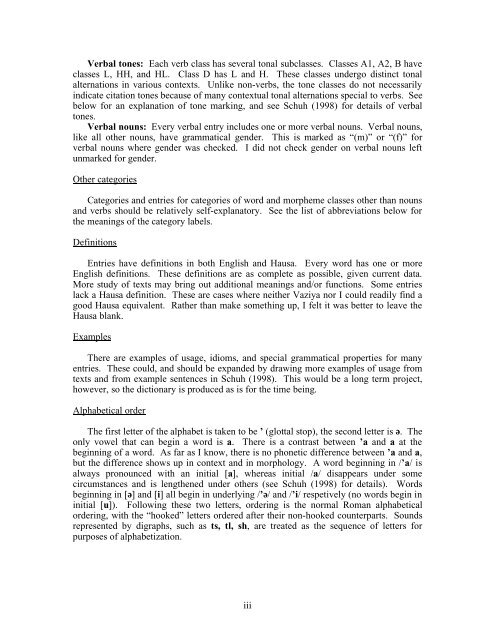miya-english-hausa dictionary - UCLA Department of Linguistics
miya-english-hausa dictionary - UCLA Department of Linguistics
miya-english-hausa dictionary - UCLA Department of Linguistics
You also want an ePaper? Increase the reach of your titles
YUMPU automatically turns print PDFs into web optimized ePapers that Google loves.
Verbal tones: Each verb class has several tonal subclasses. Classes A1, A2, B have<br />
classes L, HH, and HL. Class D has L and H. These classes undergo distinct tonal<br />
alternations in various contexts. Unlike non-verbs, the tone classes do not necessarily<br />
indicate citation tones because <strong>of</strong> many contextual tonal alternations special to verbs. See<br />
below for an explanation <strong>of</strong> tone marking, and see Schuh (1998) for details <strong>of</strong> verbal<br />
tones.<br />
Verbal nouns: Every verbal entry includes one or more verbal nouns. Verbal nouns,<br />
like all other nouns, have grammatical gender. This is marked as “(m)” or “(f)” for<br />
verbal nouns where gender was checked. I did not check gender on verbal nouns left<br />
unmarked for gender.<br />
Other categories<br />
Categories and entries for categories <strong>of</strong> word and morpheme classes other than nouns<br />
and verbs should be relatively self-explanatory. See the list <strong>of</strong> abbreviations below for<br />
the meanings <strong>of</strong> the category labels.<br />
Definitions<br />
Entries have definitions in both English and Hausa. Every word has one or more<br />
English definitions. These definitions are as complete as possible, given current data.<br />
More study <strong>of</strong> texts may bring out additional meanings and/or functions. Some entries<br />
lack a Hausa definition. These are cases where neither Vaziya nor I could readily find a<br />
good Hausa equivalent. Rather than make something up, I felt it was better to leave the<br />
Hausa blank.<br />
Examples<br />
There are examples <strong>of</strong> usage, idioms, and special grammatical properties for many<br />
entries. These could, and should be expanded by drawing more examples <strong>of</strong> usage from<br />
texts and from example sentences in Schuh (1998). This would be a long term project,<br />
however, so the <strong>dictionary</strong> is produced as is for the time being.<br />
Alphabetical order<br />
The first letter <strong>of</strong> the alphabet is taken to be ’ (glottal stop), the second letter is ”. The<br />
only vowel that can begin a word is a. There is a contrast between ’a and a at the<br />
beginning <strong>of</strong> a word. As far as I know, there is no phonetic difference between ’a and a,<br />
but the difference shows up in context and in morphology. A word beginning in /’a/ is<br />
always pronounced with an initial [a], whereas initial /a/ disappears under some<br />
circumstances and is lengthened under others (see Schuh (1998) for details). Words<br />
beginning in [”] and [i] all begin in underlying /í”/ and /’i/ respetively (no words begin in<br />
initial [u]). Following these two letters, ordering is the normal Roman alphabetical<br />
ordering, with the “hooked” letters ordered after their non-hooked counterparts. Sounds<br />
represented by digraphs, such as ts, tl, sh, are treated as the sequence <strong>of</strong> letters for<br />
purposes <strong>of</strong> alphabetization.<br />
iii

















